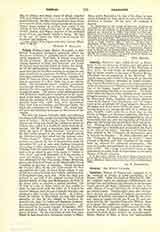

Cabral, PEDRALVAREZ (Pedro ALVAREZ), a celebrated Portuguese navigator, generally called the discoverer of Brazil, b. probably about 1460; date of death uncertain. Very little is known concerning the life of Cabral. He was the third son of Fernao Cabral, Governor of Beira and Belmonte, and Isabel de Gouvea, and married Isabel de Castro, the daughter of the distinguished Fernando de Noronha. He must have had an excellent training in navigation and large experience as a seaman, for King Emmanuel of Portugal considered him competent to continue the work of Vasco da Gama, and in the year 1500 placed him in command of a fleet which was to set sail for India. His commission was to establish permanent commercial relations and to introduce Christianity wherever he went, using force of arms when necessary to gain his point. The nature of the undertaking led rich Florentine merchants to contribute to the equipment of the ships, and priests to join the expedition. Among the captains of the fleet, which consisted of thirteen ships with 1,200 men, were Bartolomeu Diaz, Pero Vaz de Caminha, and Nicolao Coelho, the latter the companion of da Gama. Da Gama himself gave the directions necessary for the course of the voyage.
The fleet left Lisbon, March 9, 1500, and following the course laid down, sought to avoid the calms of the coast of Guinea. On leaving the Cape Verde Islands, where Luis Pirez was forced by a storm to return to Lisbon, they sailed in a decidedly southwesterly direction. On April 22 a mountain was visible, to which the name of “Monte Paschoal” was given; on the 23d Coelho landed on the coast of Brazil, and on the 25th the entire fleet sailed into the harbor called “Porto Seguro”. Cabral perceived that the new country lay east of the line of demarcation made by Alexander VI, and at once sent Andreas Goncalvez (according to other authorities, Gaspar de Lemos) to Portugal with the important tidings. Believing the land to be an island he gave it the name of “Island of Vera Cruz” and took possession of it by erecting a cross and holding a religious service. The service was celebrated by the Franciscan, Father Henrique, afterwards Bishop of Ceuta, on the island called Coroa Vermelha in the bay of Cabralia. Cabral resumed his voyage May 3; by the end of the month the fleet approached the Cape of Good Hope, where it was struck by a storm in which four vessels, including that of Bartolomeu Diaz, were lost. With the ships now reduced to one-half of the original number, Cabral reached Sofala, July 16, and Mozambique, July 20; in the latter place he received a cordial greeting. On July 26 he came to Kilwa where he was unable to make an agreement with the ruler; on August 2 he reached Melinde; here he had a friendly welcome and obtained a pilot to take him to India. At Calicut, where he arrived September 13, he met with many obstacles, so that he was obliged to bombard the town for two days; in Cochin and Kananur, however, he succeeded in making advantageous treaties. Cabral started on the return voyage, January 16, 1501, and arrived at Lisbon, July 31, or, as is sometimes given, June 23. On the way home he met Pero Diaz whom he had dispatched, during his voyage, to Magadoxo, and in September the last of his ships, in command of Sancho de Toar whom he had sent to Sofala, returned to Lisbon. Of his later life nothing is known.
OTTO HARTIG

